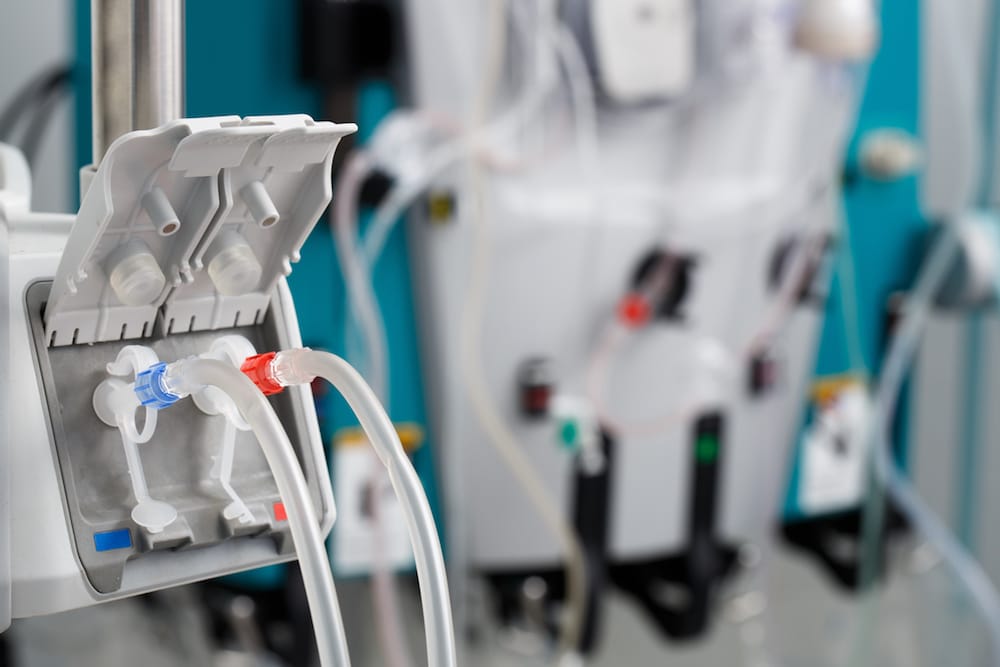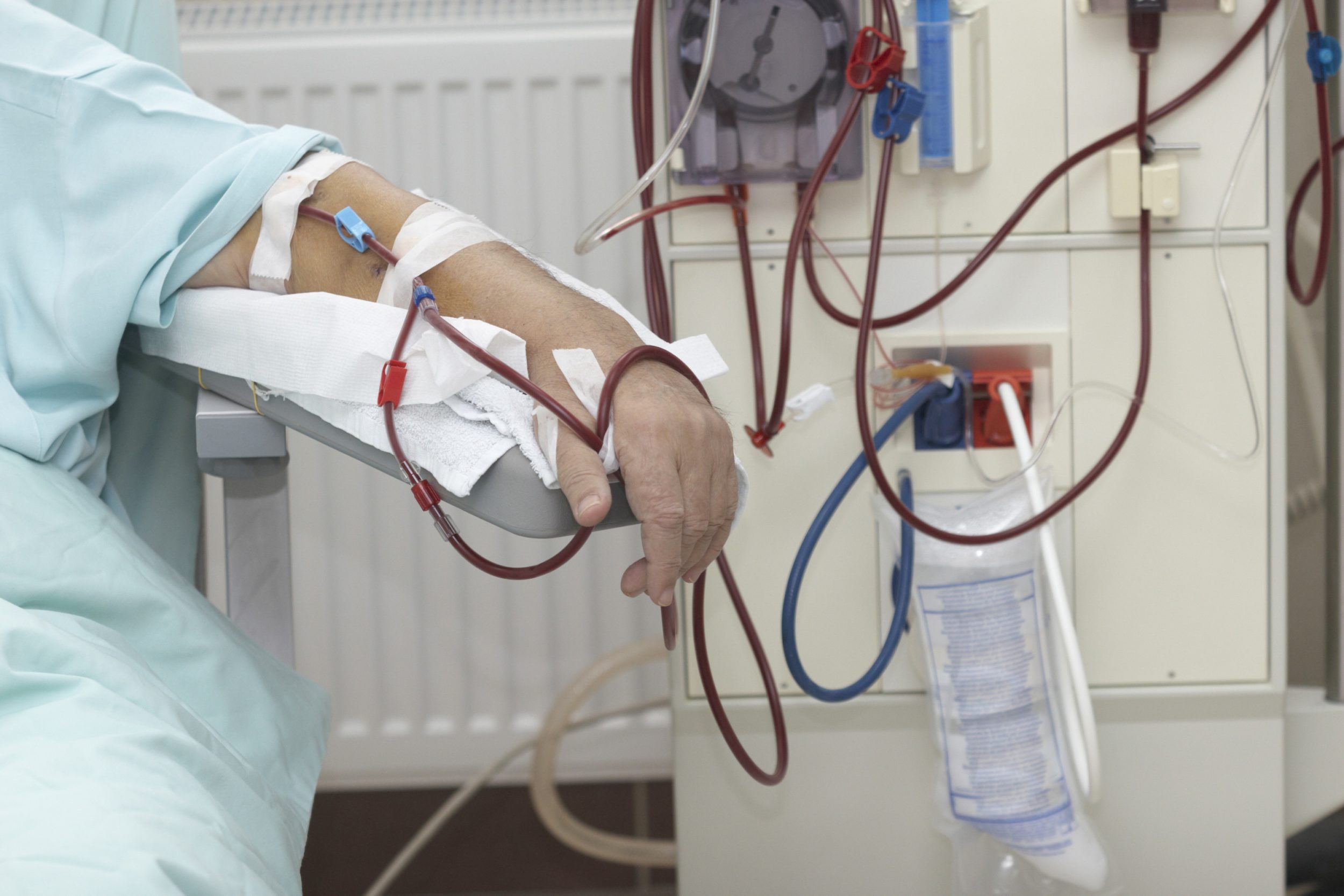Inpatient Dialysis

The kidneys are two bean-shaped organs that can be found on each side of the spine just below the rib cage. They are responsible for removing the extra fluid and waste that accumulates in the blood while it moves through the body. This waste is then flushed from the body in the urine. Without this cleaning of the blood, a person will eventually die.
When your kidneys stop working properly, called kidney failure, a patient needs dialysis to remove the impurities in the blood manually.
Hemodialysis uses a machine to filter the blood when your kidneys are no longer healthy enough to do this important job. At Summit Healthcare, we offer inpatient dialysis.
Causes of Kidney Failure
Diabetes (types 1 and 2) and high blood pressure are most often behind kidney disease. High blood sugar levels can harm the kidneys, while high blood pressure harms the blood vessels, including those that go to the kidneys. Your kidneys may also shut down suddenly after a severe illness, complicated surgery, heart attack, or other serious health problem. This is known as acute kidney failure.
Benefits of Dialysis Treatment
When your kidneys can’t remove the waste and excess fluid, dialysis can keep your body running as close to normal as possible. Dialysis isn’t a cure for kidney disease; it simply is a substitute for the kidneys.
The Dialysis Treatment

If you are hospitalized at Summit Healthcare and require hemodialysis, the equipment is brought to your room. During treatment, you remain in your room and are treated while sitting or lying in your hospital bed. A Dialysis Nurse will initiate, monitor, and complete your treatment. During treatment, a pump in the hemodialysis machine draws out your blood, and then sends it through a filter called a dialyzer. This functions like your kidney, filtering waste and removing the fluid. Then cleaned blood is sent back into your body.
Inpatient dialysis at Summit Healthcare takes from 3 to 5 hours per session. Patients usually need these treatments three times each week.
What To Expect After Your Dialysis Treatment
Dialysis enables patients to live a pretty normal life. Once a month you’ll receive these tests to ensure your hemodialysis is removing enough of the wastes from your blood:
- Blood tests to measure urea reduction ratio and total urea clearance to see how well the wastes are being removed
- Blood chemistry evaluation and assessment of blood counts
- Measurements of the flow of blood through your access points during dialysis
At Summit Healthcare, we’ll also help you eat right between your dialysis sessions. A dietician will help you develop a meal plan based on your personal preferences, weight, remaining kidney function, and other medical conditions, such as diabetes.
Risks of Dialysis Treatment
Low blood pressure is the most common risk with dialysis. These are the main risks:
- Low blood pressure
- Anemia
- Muscle cramping
- Difficulty sleeping
- Itching
- High blood potassium levels
- Depression
- Inflammation of the membrane around the heart
Long-term dialysis can also lead to other conditions, such as amyloidosis. This disease occurs when amyloid proteins produced in bone marrow build up in the kidneys, liver, heart, and other organs. This will usually lead to joint pain, stiffness, and swelling.
What is dialysis treatment?
Dialysis simply takes over the job of the malfunctioning kidneys. With dialysis, your blood is routed out of your body and through a filter. This removes the waste products and excess fluid that have accumulated. The cleaned blood then exits the filter and reenters the blood vessel.
When are dialysis treatments needed?
If you have chronic kidney disease, which doctors characterize as your kidneys not working well for at least three months, you’ll need dialysis or a kidney transplant at some point. As your kidney function continues to deteriorate, lab tests will begin to show toxic levels of waste in your blood. At this point, symptoms, such as nausea, fatigue, swelling, and vomiting, will begin to show themselves. Your quality of life will begin to be adversely affected.
A test called an estimated glomerular filtration rate (eGFR) will measure your level of kidney function. Your eGFR is calculated using your blood creatinine test results, sex, age, and other parameters. Your eGFR numbers will help you plan your treatment, including when you’ll need to start dialysis.
How does inpatient dialysis treatment work?
At Summit Healthcare, we provide inpatient dialysis. Hemodialysis uses an artificial kidney, known as a hemodialyzer, in place of your malfunctioning kidneys. The dialysis machine and dialyzer are basically a filtration system that removes the waste and fluid from your blood.
Before you can use a hemodialyzer, we need to create an entry point into a blood vessel. We use two types of vascular access for long-term dialysis treatments.
An arteriovenous (AV) fistula connects an artery and a vein under the skin in your arm. This is usually done in your non-dominant arm and it takes about six weeks to heal before it can be used for hemodialysis. After that, an AV fistula can be used for years.
An arteriovenous graft, or AV graft, use a plastic tube to join an artery and a vein under your skin. An AV graft heals in around two weeks, so you can have dialysis faster, but it won’t last as long as a fistula. The risk of infection is also greater with an AV graft.
If you need dialysis very quickly, a catheter can be placed into a neck vein, below the collarbone, or next to your groin. This entry is only meant to be used for a short time.
How long does dialysis treatment last?
If you had a sudden kidney injury and shutdown, you may only need dialysis for a short time until your kidneys recovery. But if you have chronic kidney disease the kidneys rarely improve. In these cases, you’ll either need to be on dialysis permanently or you’ll need a kidney transplant.
Is Dialysis Treatment Painful?
Once your fistula or graft has been inserted as a port for your dialysis treatments, you should not experience any pain. Even the insertion of the port is only minimally uncomfortable due to the small size of the needle and tube. During your dialysis treatments, you may experience side effects such as cramping, nausea, or dizziness. Your dialysis provider will be in your room for the duration of your treatment. If you develop side effects, let them know. They may adjust your treatment if possible without diminishing the necessary outcome.
Are There Other Medical Issues that can Endanger Dialysis Treatment?
Many people who need dialysis are affected by at least one other condition that affects their health. Your care team at Summit Healthcare develops a multidimensional approach that meets your immediate needs in the safest, most effective way possible. Regardless of coexisting medical conditions, your body must have proper kidney function to maintain various important processes. During your inpatient stay, your doctor will discuss each aspect of your treatment plan and answer any questions you have.
How Can I Help to Ensure I Maintain Good Results from My Treatment?
Before you’re discharged from MSK, your MSK nephrologist will talk with you about continuing your dialysis treatments. If you need to continue getting dialysis treatments, your Case Manager will help you find an outpatient dialysis center. The Case Manager will give you a list of dialysis centers to choose from and will coordinate your ongoing schedule with the outpatient dialysis center before you’re discharged. If your kidneys recover and you don’t need dialysis anymore, your dialysis catheter will be removed before you go home.
Should I Avoid Drinking Alcohol During Dialysis Treatment?
Consuming alcohol puts additional strain on your kidneys to filter out impurities from your body. Not only do the kidneys have to work harder to filter alcohol from your blood, but they must do so in a state of dehydration, which diminishes their efficiency. Seeing that alcohol dehydrates the body at the same time that it adds more for the kidneys to filter, most experts advise against alcohol consumption in cases of kidney disease.
How Long Does it Usually Take for Dialysis Treatment to Work?
Dialysis takes over for your kidneys. In this way, it works immediately. How long it takes for you to feel better after beginning dialysis treatment will depend on several factors. Generally, patients are expected to start feeling better within a week or two of starting their treatment. Throughout this time, the dialysis treatments continue to filter toxins out of the blood and strengthen other biological functions that support physical well-being.
Learn More
Our hours of service are Monday – Friday, 7:30 am – 4:30 pm. We offer extended hours and weekend appointments as needed. For more information call Summit Healthcare at 928.537.6363. Our practice serves Show Low, Snowflake, and surrounding areas in Arizona.
